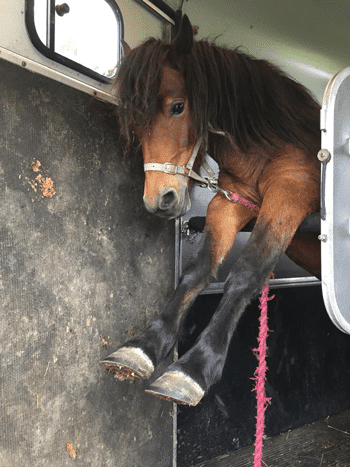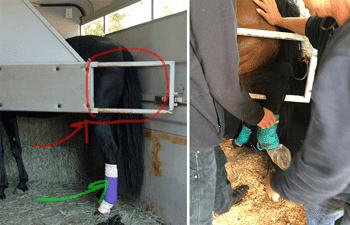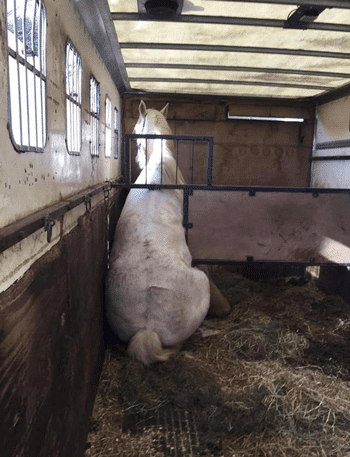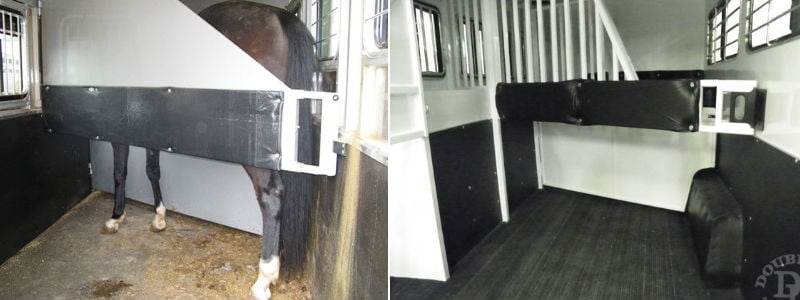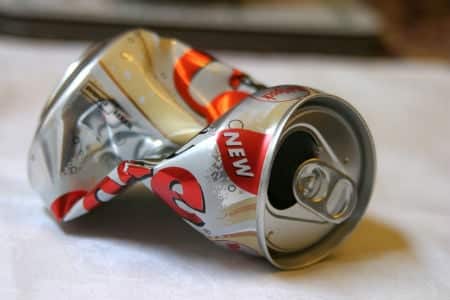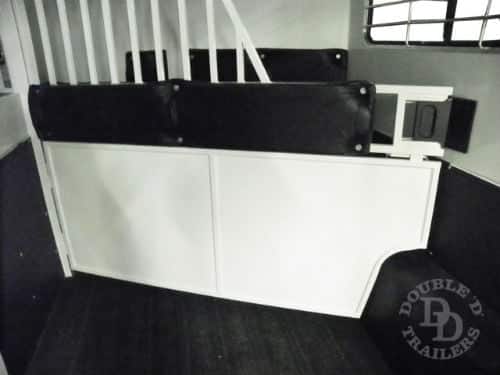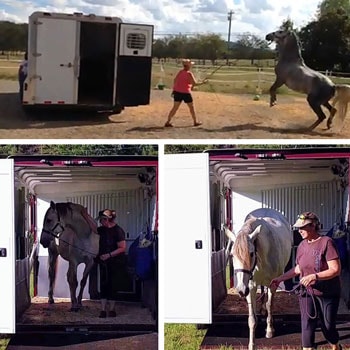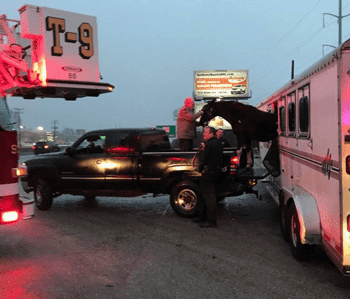Shocking Photos Reveal Common Horse Trailer Hazards: How to Keep Your Horse Safe
Horse trailer safety is always our number one concern. That’s why we spend so much time writing articles to help our readers understand how to protect their horses. That’s also why the photos below were so disturbing for us to receive.
Thanks to one of our readers named Elizabeth, we received permission to share these shocking photos. She works with a veterinary office and they’ve collected these shots to document some of the dangerous horse trailer emergencies they’ve encountered.
Remember, horses are animals. So they will act on instinct when they feel threatened. If the trailer features surrounding your horse aren’t properly designed, it’s setting the horse up for injury or worse. Here are the top features you need to avoid in your next trailer.
Butt or Chest Bars That Trap Your Horse
Chest and butt bars are designed as a simple way to keep your horse in the correct stall area. But if your horse decides to rear or kick out, it’s easy for him to trap a leg over the bar. Things are even worse if the “bar” is actually a padded chain without any sort of safety release.
A horse trapped like this is likely to scramble in panic and cause himself serious injury. Plus, if the bar is not well padded, it would be easy for him to gash open his leg.
Ideal Design for Butt and Chest Bars in Horse Trailers
The only time you should use a butt or chest bar in your trailer is if it has a removable safety pin. This would allow a handler to lower the bar even if the full weight of the horse is on top.
An even better option is to do away with the butt and chest bars all together! A slant load horse trailer can secure the horses in stalls with only side dividers… no butt or chest bars necessary.
4 Types of Poorly Designed Dividers
Unless you’re using an open stock trailer, you’ll likely have dividers holding your horses in their individual stalls. Many horse owners don’t give these dividers a second thought. But really, their design can have a big impact on the safety of your horse. Here are five common divider problems we see in horse trailers.
PROBLEM #1: Rear Legs Stuck in Dividers
One of the problems we’ve seen is big gaping holes in the dividers near the horses’ rear ends. If a horse decides he doesn’t like his neighbor, he might kick out in frustration. It would be easy for him to get a leg stuck in this hole resulting in serious injury. That’s what happened in these photos below.
PROBLEM #2: Very Large Gaps at the Front
On the other end of the spectrum is a divider with large gaps closer to the horses head. Many owners will agree, horses have a tendency to get themselves into all sorts of weird positions. That’s why your trailer needs to be well designed to protect them regardless of the pretzel they twist themselves into.
This horse may have become unbalanced while traveling. He fell down and then slid under the front side of the divider until he was completely stuck.
PROBLEM #3: Completely solid head divider.
Some dividers take the complete opposite approach. Rather than having too many openings, they have too few! That’s what happened in this photo. The divider is a solid sheet of metal from top to bottom.
Horses are naturally claustrophobic, so this set up is going to make your horse feel very nervous. There's a good chance horses who ride in this trailer will resist loading and explode off the trailer when it comes time to offload.
PROBLEM #4: Dividers that don’t latch securely.
The final problem has to do with the latch on your divider. Often times, this includes some sort of pin that is slipped into place. Over time, the interior metal may rust in such a way that this pin no longer fits easily. The result is a divider that is only partially secured.
We've also seen several instances where the horse leans against the butt side wall enough that it flexes outward. This causes the divider to come "unlatched." We've seen this happen with more than one brand of trailer. You'd think the walls would be sturdy enough but they aren't in a lot of cases.
When dividers come unlatched during travel, they swing over to rest against the ribs of your horse. Not only is this uncomfortable and scary for them. It also has the potential to cause serious injury, especially if the next door stall is empty and the divider begins to swing wildly with the motion of the trailer.
PROBLEM #5: Aluminum Dividers that Twist and Tear
Have you ever tried to twist an empty aluminum can? Did you notice how the metal bends easily and then starts to tear into sharp edges? Now imagine that inside your horse trailer!
Some aluminum horse trailers use aluminum for the dividers. Yup! You see where this is going. It’s a horrible choice of metal because any sort of trauma to the dividers could result in jagged sharp edges that would do serious injury to your horse.
Recommended Divider Features
Your divider should be a solid piece from chest to tail with padding to protect your horse. This way, the animal can’t trap a front or rear leg. While the divider doesn’t have to go all the way to the ground, we do recommend stud gates if you have a horse who tends to kick out at his neighbors. We also recommend using Z-Frame material because it combines strength and long last durability.
The latch needs to secure tightly so it doesn’t come undone. A tight latch also means it won’t rattle while the trailer is in motion. A quiet trailer will keep your horse calmer and more comfortable.
Finally, tubular head dividers with bars placed close together will allow air and sunlight to circulate around the trailer. Plus, it lets the horses see their surroundings including their travel buddies. We don’t like tubular head dividers with bars placed too far apart because there’s a risk of the horses biting each other or getting their heads stuck.
Horse Owners Crushed by Rear Tack in Slant Load Horse Trailer
If there’s one feature we try to educate horse owners on, it’s this one. That’s because the dangerous presented by stationary rear tack areas is enormous.
Conventional slant load horse trailers often have a very narrow doorway in the back. That’s because a rear tack area is positioned in the back corner of the trailer. During loading and unloading, horses who rush the process are likely to slam their handler into this door frame.
We’ve heard time and again stories of horse owners being seriously injured while trying to load or unload through a narrow rear opening. Not to mention - a horse isn’t often willing to load through these tiny doorways!
Safer Alternative
A much safer design can be seen on our patented SafeTack horse trailers. The rear tack area swings out like a second door. This allows a wide open rear of the trailer for loading and unload.
The extra space makes things much safer for the horse and handler. Plus, horses feel less threatened and more comfortable loading when they have a little extra elbow room!
Improperly Sized Windows
It’s common for you to open the windows of your trailer so horses can get a bit of fresh air. You might be taking a quick break at a gas station or you’ve just arrived at the show grounds.
There’s a pretty big problem with this though… the big window!
When horses see a wide open space in front of them that leads to freedom, they naturally think they can leap right through. It sounds crazy, but we’ve heard multiple stories of vets and emergency crews being called to help get horses unstuck.
Optimal Horse Trailer Window Design
Make sure your windows are properly sized. They shouldn’t be so large that your horse feels like he can leap through to freedom. They also shouldn’t be so small that they don’t allow in any light.
Some trailers will use big windows so their trailers feel bright and airy. You can accomplish this same feel with properly sized windows. Just make sure the interior of your trailer is painted white to reflect light. Windows on the butt side of the trailer can add light while tubular head dividers can help as well.
Book a FREE video consult to make every trip with your horse safe!
